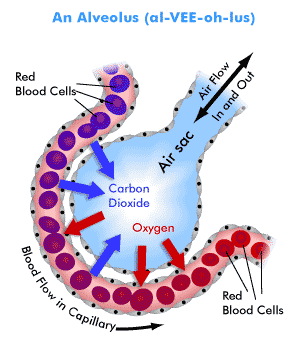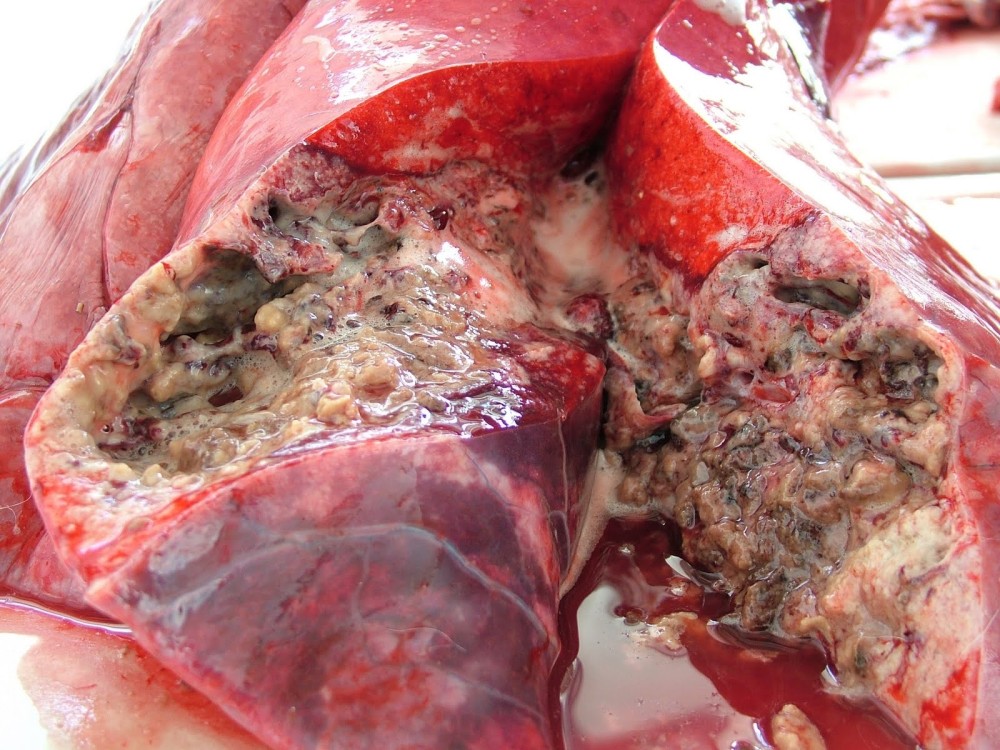Author: Qutub Khan Vajihuddin, Learner at The Integral School, Hyderabad. This is an independent self directed project exploring various aspects of the human gas exchange system (otherwise known as the respiratory system).
The human gas exchange system
The human gas exchange is otherwise known as the Respiratory System. The human gas exchange system is important as it provides us with a continuous supply of oxygen for respiration and rids our body of carbon dioxide that is a waste product of respiration. Too much of carbon dioxide can harm the organs of the body. Usually a person breathes around 12 to 20 times in 1 minute. That adds up to 17000 to 30000 breaths per day.

The lungs are enclosed in the thorax (chest) by the ribcage and muscular tissue called the diaphragm. The intercostal muscles join the ribs together. There are 2 types of intercostal muscles, internal intercostal muscles and external intercostal muscles.
The diaphragm separates the abdomen from the thorax. The diaphragm has a fibrous middle and tough edges that make the walls. The only thing separating the lungs from the thorax are 2 slim membranes called pleural membranes. These form an airtight seal around the lungs. In between these 2 membranes there is a space called the pleural cavity that is filled with liquid called pleural fluid. This acts as a lubricant when the lungs expand and contract. If there is less fluid, for example, when the chest wall is punctured then the lungs would not expand because there would be no surface tension that makes the lung move. So the lung would collapse. If there was too much fluid then you would also have difficulty breathing and the lungs would not be able to expand. This usually causes lung failure.
When you breathe in, the outer intercostal muscles contract pulling the ribs up and out. The diaphragm contracts and flattens at this time. These movements create low pressure causing the air to come rushing in. When you breathe out the internal intercostal muscles contract pulling the ribs down and in. The diaphragm relaxes and goes back to its dome shape. This time these movements create higher pressure than the outside atmosphere and they squeeze the lungs so the air goes rushing out. Think of lungs as balloons. They empty like balloons empty and fill up just like balloons take in air.

The breathing rate can be increased and decreased when needed. The rate is increased when receptors in the brain sense the carbon dioxide building up in the blood and they send nerve impulses to the the intercostal muscles and the diaphragm muscles. The lactic acid that builds up and the carbon dioxide that is in the blood need to get removed. So the breathing rate slowly decreases as the lactic acid and the carbon dioxide decreases. After an intense workout, it would take around 3 minutes for your breathing to reach its normal rate.
Breathing rate is measured in a spirometer. The volume of air breathed in and out normally is called the tidal volume. The maximum inhalation and exhalation is called the vital capacity. Even after someone breathes out as much as they can there is always an amount of air left in the lungs. This is called the residual volume. This is very important because it prevents the lungs from collapsing.
The air enters from the mouth or the nose. The nasal airways are kept moist by mucus secretion. The nasal airways humidify the air that is entering. This increases the amount of water vapour the air contains (That is why it is better to breathe in through the nose). The water vapour keeps the lungs from drying out. After that the air enters the trachea (windpipe). Lining the trachea wall are special cells that play an important role. Some cells secrete mucus that traps the bacteria. The other cells are covered with hairlike things called cilia.
There are 2 types of cilia, motile and non motile. The non motile cilia are typically sensory organelle. The motile cilia normally clean away the dirt particles. The cilia in this windpipe sweep the bacteria filled mucus out towards the mouth. This prevents the bacteria from entering the lungs and causing any infections.
The trachea splits into 2 pipes called bronchi. Each one leading to each lung. The walls of the trachea and the bronchi have c shaped cartilage rings that prevent the pipes from collapsing on itself when sucking air in. Each Bronchus divides into smaller and narrower tubes called bronchioles. This network of tubes is called the bronchial tree.
Eventually when a bronchiole ends the alveolar duct starts. These tubes lead to microscopic air sacs called alveoli where the actual gas exchange happens. The alveoli is very efficient because it brings the air and the blood very close together over a large surface area. The lungs contain around 700 million of these tiny air sacs. This gives a huge surface area of 60 m2. The alveoli are like bunches of grapes surrounded with blood capillaries. Only gases can diffuse through the walls.
The blood is separated from the air by 2 cell layers, the alveolus wall and the capillary wall. The Carbon dioxide rich blood comes from the heart in an arteriole and because of a lesser concentration of carbon dioxide in the air it diffuses in the air. The oxygen in the air diffuses in the blood due to low amounts of oxygen. The oxygen rich blood goes back to the heart in a venule and the carbon rich air gets exhaled. The process is then repeated.

Tuberculosis
Every year, around 8.6 million people are diagnosed with this disease globally. The disease can be fatal if not diagnosed early. Annually, approximately 1.3 million people die of Tuberculosis due to not getting the antibiotics and drugs needed to cure it.
Tuberculosis (TB) ( Its is in the bacterial division mycobacterium. These cause serious diseases like leprosy) is a bacterial infection that can spread through the body via the bloodstream and lymph nodes. They thrive in places that are rich in blood and oxygen. That is why the bacteria is mainly found in the lungs. It is a contagious disease. It cannot be spread through touch. You normally need to spend many hours close to someone who is infected to get it. Another type of TB is Drug resistant TB and multi drug resistant (MDR) TB. This TB can happen when the bacteria become resistant to the most powerful antibiotics used to treat the illness. It would take around 2 years to cure this.
When the bacteria enter the body, it infects an area. However if you have a healthy immune system then the body fights the infection by encapsulating the bacteria into capsules called tubercles. The bacteria don’t die and they can’t spread but they stay inactive (latent). Most people don’t go beyond this point. the TB becomes active and it affects the infected organs in people whose immune system weakens. The body is unable to fight the infection and it spreads very rapidly. It is fatal if untreated. The immune system may be weakened due to several reasons, including diseases like AIDS, Cancers, and other conditions like poor nutrition that impact on the immune system of the body.
The symptoms of active TB in the lungs are coughing with blood, chills, fatigue, night sweats, loss of appetite and weight and fever.
If the infected areas are the lungs then this can lead to the formation of pockets in the lungs. These may bleed in the lungs or become infected with other bacteria forming pockets of pus. Holes can form in the airways that get blocked. This results in difficulty in breathing.
If the infected area is the bone then this can lead to pain and joint destruction. If infected area is the brain it can cause meningitis. This disease can infect any organ in the body. A lung with active TB may look like this.

The most common way to diagnose tuberculosis is by giving an injection in the forearm (the Mantoux test). After 2 to 3 days the forearm should be checked and if there is a red swollen bump then you have TB. The red swollen bump indicates an immune reaction and usually tells that you have the tuberculosis bacillus in the body (either active or latent). Further tests and correlation with signs and symptoms are necessary to find out if the tuberculosis is active or not. The disease is cured by taking Antibiotics depending on your age and gender. Infants, children and people with HIV and AIDS need special care. Generally you would have to take them for around 6 months. Vaccines partly protect you from it. Though side effects to medications are uncommon, they include dark urine, fever and jaundice. You could have TB and not know about it.
Nicotine and smoking
Smoking is a very bad habit. It is very addictive due to a drug called Nicotine. Nicotine is highly toxic however the amount inhaled when smoking is too small to cause immediate death. Quitting smoking may be tough but you can use Nicotine patches and gum to help you. These patches and gums have Nicotine in them that get absorbed in the blood stream and they lessen the craving for smoking.
Each cigarette contains around 10 mg of nicotine. A smoker would breathe in about 1 or 2 mg of nicotine each cigarette. Nicotine is absorbed through the skin and the nose and mouth. When you smoke nicotine, it reaches the brain in only 10 seconds. Nicotine activates the circuitry (reward pathway) in the brain which regulate the feeling of pleasure. It also activates dopamine in these airways. The drug levels peak after just 10 seconds and the effects subside after a few minutes. This leads to the continuous intake of drugs or cigarettes throughout the day.
Smoking is very bad for you. It has all kinds of chemicals that harm your body. When you smoke there are chemicals that you breathe in that go through the breathing system damaging your body. The cilia lining the trachea get destroyed by the chemicals. Therefore mucus is not swept away. On top of that the smoke irritates the airways stimulating the mucus producing cells to secrete more mucus. So the throat gets blocked more than it already has. That’s why smokers cough. The disease Bronchitis is caused by this and infections from bacteria in the mucus. The person with bronchitis has great difficulty in breathing.
Chemicals also damage the walls of the alveoli that break down and fuse together making irregular air spaces. This reduces a huge amount of the surface area. This makes the gas exchange system inefficient. This is why smokers are out of breath very quickly. This disease is called Emphysema. In serious cases, patients are unable to carry out even straightforward activities like walking. Moreover they usually need a supply of oxygen near them at all times.
One of the chemicals in smoke is carbon monoxide. This chemical enters the bloodstream and interferes with the ability of carrying oxygen around the body. It combines with the hemoglobin, making carboxyhemoglobin, more tightly than oxygen therefore not letting oxygen combine with hemoglobin. The result is less oxygen around the body and a higher chance of having a heart attack.
On the other hand a very serious problem caused by smoking is cancer. Chances of getting cancer increase highly if you are a smoker.

Cancer is a disease. Smoke has 17 chemicals that cause cancer. These chemicals are called Carcinogens. They are contained in the tar that collects up in a smoker’s lungs. Cancer occurs when cells began to mutate and divide abnormally and very quickly. This creates a tumor. This can spread throughout the body if not taken care off. The tumor goes by mostly unnoticed until it’s too late because they cause no pain. This can be fatal.

One Comment Add yours